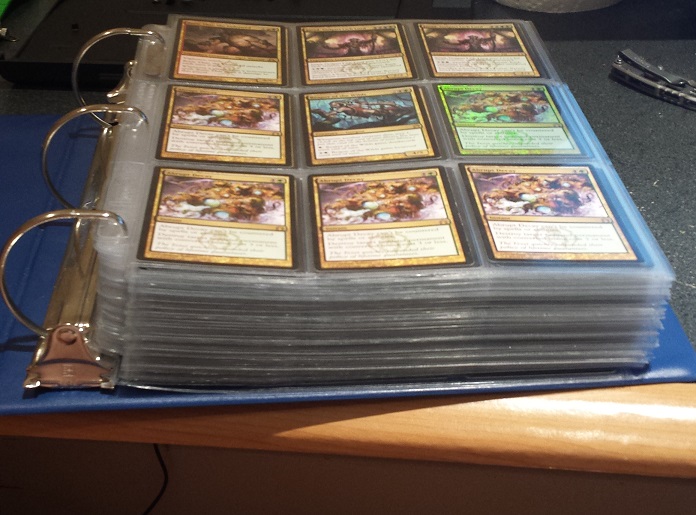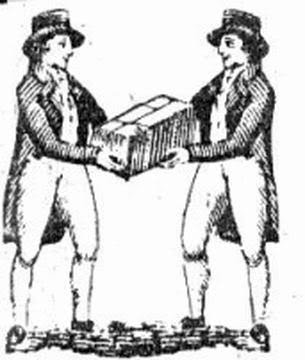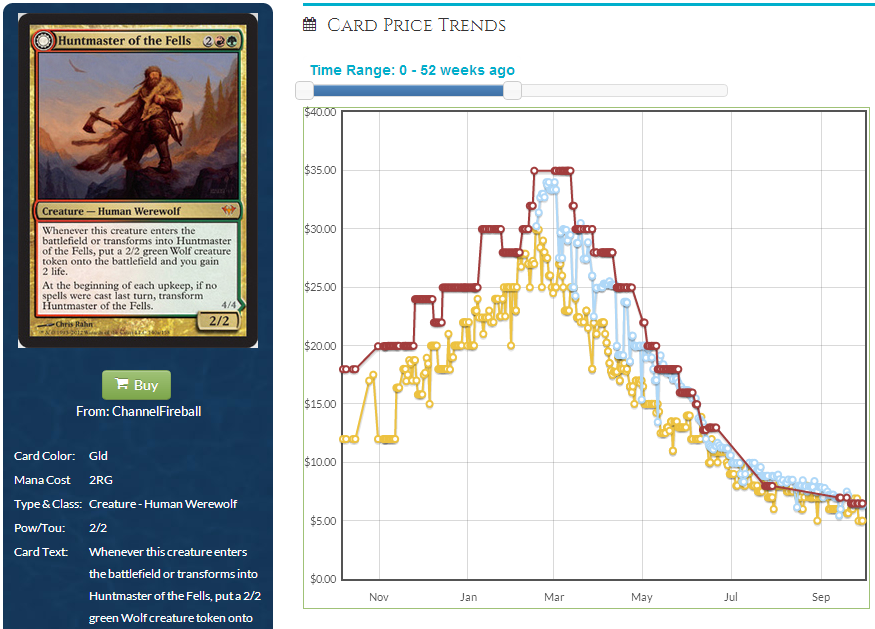Today we’re going to talk about one of the best tools of the value seeker: the trade binder.

Most people that read this article series – or any financial article series really – will have a trade binder. It’s the most common way for the event-attending mage to leverage their knowledge and tactics. Within the last 9 months I came to realize just how important actually having an available binder with decent cards is, and I want to share that experience with all of you.
For years now I’ve had a trade binder or two ready and available. I carried them with me to most Magic events, and did a great job of growing my collection with just incidental trading wherever I could.
This past March, three factors led to the near-total dissolution of my binders. The first was that I had acquired a few collections, and I had moved a major quantity of cards out of my trade binder and into a box that was exclusively for sale online. (If you’re curious about why I would do that, refer to the linked article.) This removal of many high value cards from my trade binder drastically reduced my potency at trade tables.
The second factor was that I had just signed onto a six-month job contract in March, and subsequently was flying out of state every Monday through Friday. The inability to attend any Magic event during the week – including FNM – meant that the number of opportunities I had to trade decreased significantly.
The third was my Return to Ravnica (RtR) holdings. Because I was going to be out of state so often, I would not get to play much Magic over the summer. I quickly traded all of my good Innistrad block cards such as Huntmasters, Bonfires, etc. into undervalued RtR cards such as Jace, Architect of Thought (who was under $10 at one point.) It did not take long before I had a big ol’ pile of RtR cards that I knew would go up after Theros, but in the short term I had little left that anyone actually wanted.
The culmination of these factors was that I had few cards worth trading, and fewer events still at which to trade them away.
What I found occurring was that when I did manage to land early enough Friday afternoon to make it to FNM or the odd Saturday afternoon draft, I would be regaled with great trades of fellow binder grinders such as the effervescent Joe Shea of the Slam Dunklers podcast, whom some of you in the Northeast may recognize from prior GP and SCG events by the late-nineties Dr. Seuss Cat-in-the-Hat.
I would invariably find myself slightly jealous that peers would stumble upon these great trades with people that valued their Force of Will at $30 or your Praetor’s Grasp at $3. I would bemoan my lack of bad luck and inability to find these soft trades that do wonders for increasing your Magic net worth. Months prior I had been able to profit similarly, but now I just could not get a good trade to save my life.
The truth of the matter was not that Joe or anyone else was particularly luckier than I was, or that I was necessarily a worse trader. Rather, it was more an effect of availability.
We never stray too far from the concept of opportunity cost when discussing Magic finance, and I think that’s really a central idea of what I’m discussing today. To use what I assume is a sports metaphor, “you miss 100% of the shots you don’t take.” The reason I was not finding great trades was not because I was asking the wrong people or that others had gotten there first. It was because I did not have anything to offer them that would allow for these interactions.
Consider Rakdos’s Return. I currently have a playset or two sitting in a plastic sleeve at home, waiting for them to jump. I picked them up between $2-$4 each, and I’m holding out for $10, or $15 if I’m lucky. If they hit $8 or $9 by December, not unreasonable numbers, I will have “made” about $4 to $7 on each copy. That’s a pretty solid profit margin on an individual card.
There is a real cost to having that card socked away in a drawer for months however. A playset of that card at my house is $20 not in my binder. It’s $20 that I don’t have the opportunity to trade to someone. You never know what random player is going to have a miscut Daze in their binder and is dying for Rakdos’s Returns.
If there’s a guy with an Avacyn in his binder that he values at $10 (currently $16), and he gives you $6 on your Rakdos’s Returns (currently $5.75), then you can easily get his Avacyn for your two Rakdos’s Returns. At that point, you have essentially traded your Returns at $8 apiece – which is what you were waiting for them to be anyways, and you did it as early as months ahead of schedule. This may sound like a dream scenario, but if you trade with any regularity, you see trades like this all the time. I am constantly finding people with outdated price models, and it is easy to exploit that if you know your data and act quickly. (As in, offer trades before they whip out their smartphone.)
Remember – a card in your binder is not a card you have already traded away. It’s a card you might trade. This is an important distinction. Just because you like a card for short or medium-term gain, it does not mean you need to pull it aside and sit on it until you get there. By leaving it in your binder, you are increasing your number of potential trades and trade partners.
You may even find trade partners you would not have otherwise by virtue of having more cards available. Someone not in the mood may turn down your trade request. But if his buddy is looking through your binder and sees a card he knows his friend wants, there’s a good chance he’ll tell him. That’s a great way to be one of the only people to see that individual’s trade binder that day.
You do not need to put every copy of a card you have into your binder either. I have quite a few Deathrite Shamans, but I only put two into my binder. I was not keen on trading them at their retail price of ~$13, but you never know. Lo and behold, at a release event this Saturday, someone flipping through my binder saw them and asked “Are these for trade? They’re like $20, right?” That conversation worked out well for me.
Remember too that you are not required to slavishly adhere to any particular prices, regardless of what someone else’s phone says. If an individual wants to give you $5 on your Rakdos’s Returns, even if that number is fair, you are not obligated to accept it. Simply inform the other party that you understand that is the fair market price, but you are not ready to trade them away at that rate. 95% of people will accept that and move on. Those individuals that really want the card may be willing to give you more on them if they really need them, at which point you’re getting the value out of your cards that you wanted to in the first place.
Before you dump every card you own into sleeves, there are certainly some cards that are not worth putting in a trade binder. Back in July I would not have included my Jace, Architect of Thoughts for the sole reason that I would have gotten tired of telling people I didn’t want to ship them for $14 apiece. I also would not bother with Exquisite Blood, because there will be so few interested in that card as it is, you may as well save your back the extra weight and let them appreciate in dusty storage. Make sure you don’t overload your binder either. Nobody wants your Cho-Arrim Bruiser.
The next time you sit down at FNM and open your binder, imagine that 10% of your cards have an animated line tracing an arc to a random individual in the room. Those lines are potential trades that have a chance to be very profitable for you. The less cards in your binder (or if you don’t have one at all), the less of those lines will appear. The more of those connections you can see, the better you’ll do that day.
I missed a solid six months of good trading to learn this lesson. I hope all of you can learn something from it.
The latest hot news:
- There are few copies of Chandra, Pyromaster under $30, and all foils are gone as of the evening of 9/30. I watched the price move drastically all day long.
- Stormbreath Dragon is a solid $30 right now. I’ll be selling at least two of my three sets.
- Jace, Architect of Thought is bare minimum of $22. I don’t think he’s quite done yet, but I’m moving most of my copies anyways.
- Blood Baron is easily $14, up from ~$7-8, despite not having done all that much at the SCG event this weekend. Not entirely sure why it moved more than Obzedat, but there you have it.


Blood Baron is higher than Obzedat because it’s seeing more play since it’s not Legendary and is fine in multiples. It’s also easier to cast, has protection from most of Esper control’s removal spells (a deck which saw quite a bit of success at SCG Worcester) and a mythic Vampire from an underopened 3rd set.
” I am constantly finding people with outdated price models, and it is easy to exploit that if you know your data and act quickly. (As in, offer trades before they whip out their smartphone.)” This sounds like the textbook definition of contemporary sharking/scumming guy.
It’s one thing if they know the disparity and are OK with it. You can still grind value like this, especially if you’re the goto guy helping people meet needs quickly and openly “charging them a premium” for that service. But taking advantage of people before they have a chance to get informed is a bit cro-magnon. You give grinders a bad name when you do this.
David, I don’t expect to change your mind, but I will reply to this so that others may read it.
I spend a non-insignificant amount of time each week keeping track of price changes. It’s unlikely anyone in a given store spends as much time as I do tracking price spikes, seeing cards lose value, use new information to predict changes, etc. I’m devoting easily 10-15+ hours a week reading or thinking about MTG prices. Spending that time comes at a cost, and the information I gain has value.
This knowledge that I have that others do not is a competitive advantage. We’re all familiar with the old adage that knowledge is power, and few will disagree. Having more information about the current state of prices is a way for me to gain value during trades, and I’m going to look to leverage that in the best ways that I can.
Furthermore, it is not my prerogative to update fellow traders when they have old information. Once someone is over the age of 20, they’re completely capable of acquiring any of this information for themselves. Why should I give them for free what I spent hours researching?
Let me use two examples to illustrate my point. Imagine first that on a Friday night, you spend your night studying and taking notes while a friend goes off to parties and enjoys life. Come Sunday afternoon, they want the concise, useful notes you gave up your entire Friday night to create. If they’re a good friend you may share them, but there will undoubtedly be resentment. You did all the work while they had fun, but then they received all the fruits of your labor for free.
Or perhaps there is a woman with her house for sale at a reasonable market rate. She’s just an average individual looking to sell her home. You’re a local developer, so you keep track of the real estate news. By keeping your ear to the ground, you find out that the local university wants to expand into the land this woman’s house is on, and the value of her land is about to skyrocket. You quickly approach her, and offer to buy her house for the listed price. Does this make you an awful person? Should you instead ring her doorbell, inform her the house is now worth 4x what it she has it listed for, and offer to pay that new rate?
The point I’m making is that I, and many others, spend a great deal of time and effort cultivating knowledge so that we are better prepared to make deals at trade tables. I have no incentive or obligation to update strangers with outdated information. I will however often share my knowledge when trading with friends – someone I frequently draft with just the other day tried to trade me his pack foil Sulfuric Vortex for $7, at which point I stopped him and informed him of its true value.
I will clarify here that I am completely against lying. If someone thinks my Deathrite Shaman is $25, I’m not going to correct them, but if they instead asked how much it was worth, I would be completely honest. I also don’t try to make money on anyone that appears to be under the age of 18. Additionally, I won’t allow for massive discrepancies. I’m ok with making value on a trade, but I’m not going to let someone trade me their Stormbreath Dragon for my Bogardan Hellkite 1:1.
There is real value in the additional information I have that my peers do not. One of the best ways to capitalize on that information is to make trades quickly, before the other individual pulls out their phone and begins checking every card to the cent. This isn’t scummy behavior, it’s good trading practice.
good elaboration. this makes it sound much more complex and human. so I appreciate the response. I don’t exactly take issue with you being more informed, and especially with knowing trends that make certain cards undervalued by the market (your university example). I think The problem for me was the combination of exploiting knowledge disparity and trying to move quickly before people can check on a smart phone. I don’t begrudge grinders getting their value, but I think there is a lot of black and white and very little grey area as far as ethically getting value due to knowledge vs taking advantage of people who are less informed.
-D
The idea of stopping people before they check the price on their phone (or otherwise high-pressure trading/sales techniques) is the part that’s scummy.
The “what do you value this at” questions that are at the heart of every sharker is the bad side of this hobby, with grown men trying to fleece casuals out of their Kiki-Jikis in exchange for Akron Legionnaires because the numbers are bigger.
If you want to speculate on cardboard rectangles instead of penny stocks, that’s fine, do that online and between dealers who are similarly about the money. But if someone is trying to finish their 78-card Angel deck, don’t 1-for-1 them on a Blinding Angel-for-Griselbrand trade.
I really like this site when the articles are about price trends and watching growth or analyzing new spec targets, but when it gets down to trading to people for cards they want to play, rather than speculate on, it gets a little scummy.
Just wanted to say I really enjoy your articles here on MTGPrice! They’re always very well-written and insightful. Keep up the good work!